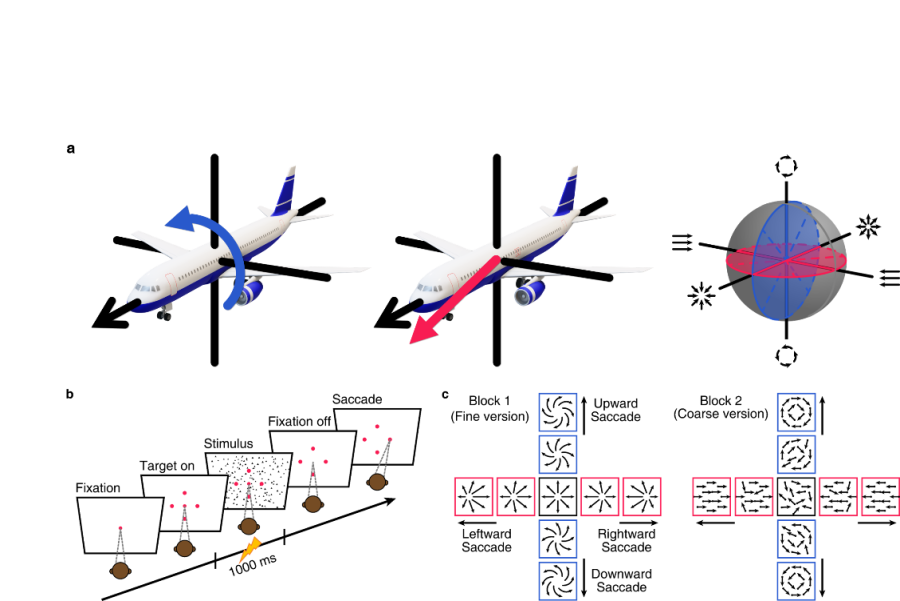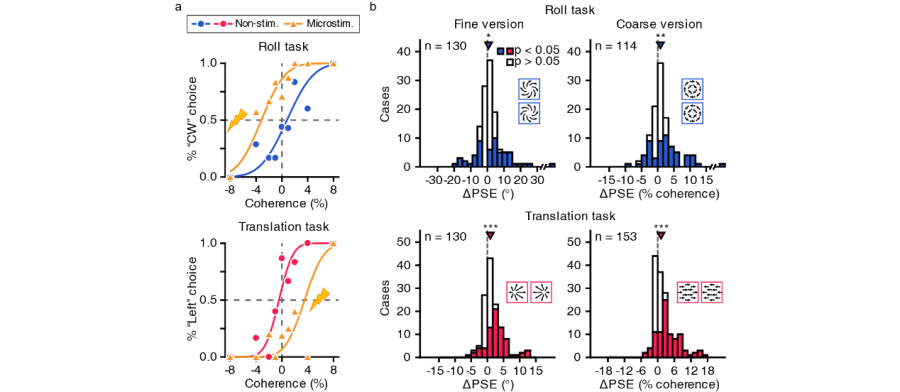Time:2022-09-20
A recent study published in Nature Communications by GU Yong’s lab at the Institute of Neuroscience, Center for Excellence in Brain Science and Intelligence Technology of the Chinese Academy of Sciences reveals causal contributions of the macaque extrastriate visual cortex in optic flow based roll perception. In this study, with extracellular electrophysiological recording and electrical microstimulation in awake, behaving macaques, the researchers provide direct evidence showing that roll signals in macaque extrastriate visual cortex causally contribute to rotation perception around line-of-sight.
Optic flow is a powerful cue for inferring self-motion status which is critical for postural control, spatial orientation, locomotion and navigation. Previous studies have shown that neurons in extrastriate visual cortex (MSTd) are predominantly modulated by complex optic flow patterns, including rotation, and mixed rotation-translation (i.e., spiral), yet a functional link to direct perception is lacking.

Figure 1. Experimental protocol for 4-AFC paradigm
a Roll (left), heading (middle) self-motion, and their combinations in 3-dimensional coordinate (right).
b Events flow in the 4-AFC discrimination task. Each trial is initiated with a center fixation point and four choice targets appeared symmetrically around the fixation point (top, down, left, and right), corresponding to roll-rotation and linear heading optic flow pattern.
c Schematic plot of optic flow patterns for the task in fine (left) and coarse (right) version.
To fill in this gap, researchers in Gu’s lab trained macaques to perform a four-alternative forced choice (4-AFC) task including roll and translation direction discrimination. In this task, macaques were required to identify flow patterns as well as direction in roll (CW versus CCW) and translation (leftward versus rightward). The researchers then applied electrical microstimulation to selectively manipulate activity of a population of clustered MSTd multiunits and examine subsequent changes in the animals’ behavioral performance. They found that microstimulation frequently biased animal’s roll perception as well as translation perception towards coded labeled-lines of the artificial-stimulated neurons. Choice frequency was also altered between roll and translation flow-pattern. Their results provided direct causal-link evidence supporting that roll signals in MSTd, despite often mixed with translation signals, can be extracted by downstream areas for perception of rotation.

Figure 2. Microstimulation biased roll and translation perception
a Example psychometric functions for non-stimulated trials (control trials, blue symbols for roll task and red symbols for translation task) and stimulated trials (orange symbols).
b Summary of microstimulation-induced PSE shifts (ΔPSE) in 4-AFC task for fine and coarse versions.
This work entitled “Causal contribution of optic flow signal in Macaque extrastriate visual cortex for roll perception” was published online in Nature Communications on September 19th, 2022. The research was conducted together by students LI Wenhao and Lu Jianyu under the supervision of Dr. GU yong at the Center for Excellence in Brain Science and Intelligent Technology. ZHU Zikang also contribute to data collection. This study was supported by grants from the Ministry of Science and Technology of P.R. China, Chinese Academy of Sciences, and Shanghai Municipal Science and Technology Commission.
Key words: optic flow signal; roll perception
Author contact:
GU yong
Center for Excellence in Brain Science and Intelligence Technology (Institute of Neuroscience), Chinese Academy of Sciences, Shanghai, China.
E-mail: guyong@ion.ac.cn
 附件下载:
附件下载: